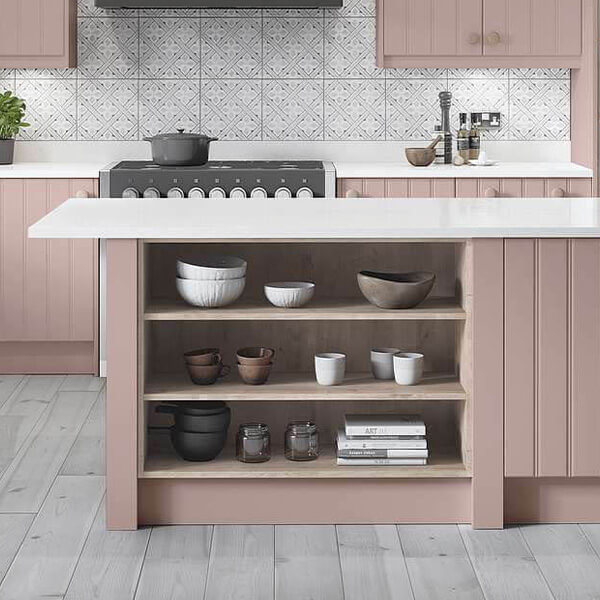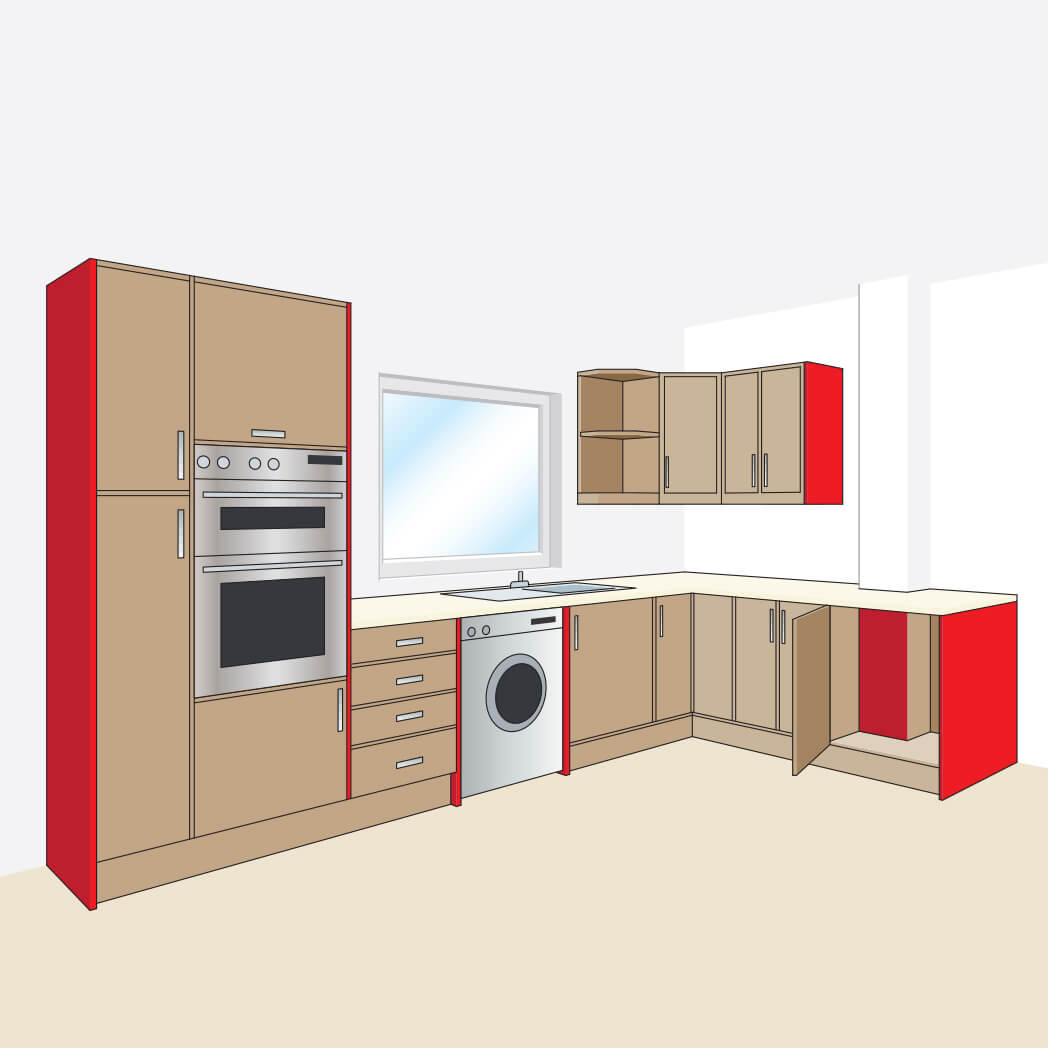The Essential Guide to Kitchen End Panels: Sizes, Styles, and Functions
Uncover the often overlooked yet crucial components of your dream kitchen: End panels. Learn about their sizes, types, and roles in elevating your kitchen’s design.

Understanding the Unsung Hero of Kitchen Design: End Panels
When envisioning your dream kitchen, it's easy to get swept away by the allure of sleek cabinets, sparkling worktops, and high-end appliances. But there's another player in this game that's equally vital, though often overlooked: the end panels.
These are the unsung heroes that wrap around the exposed ends of your cabinets, pulling together your entire design vision.
Think of end panels as the finishing touch, like a beautifully wrapped gift. They are not just aesthetic add-ons; they serve a functional role, too.
By hiding exposed edges and creating a continuous look, end panels help make your kitchen more than just a collection of furniture. They transform it into a cohesive space.
Types of End Panels
End panels come in a variety of configurations tailored to different areas of your kitchen:
- Base End Panel: Commonly used at the floor level, these panels often sit directly on the floor and finish off the sides of your base cabinets.
- Wall End Panel: These are customised to complete the appearance of cabinets installed on the wall.
- Tall End Panel: Designed for tall or larder cabinets, these panels usually run from the floor to the ceiling, adding a streamlined effect.
- Dresser End Panels: Perfect for kitchen dressers or hutch-style cabinets, these panels add an extra level of detail that makes your furniture look bespoke.
- Breakfast Bar Back Panel: For breakfast bars or island benches, these back panels add an elegant finishing touch, wrapping around the back or sides as needed.
- Island End Panels: These panels are specially cut to cover the exposed sides of your kitchen island, creating a unified look.
Depending on your design theme, the end panels come in various styles, ranging from plain or T&G, so there's always something to match your aesthetic.
Sizing and Installation: A Closer Look
End panels are not a one-size-fits-all affair. They usually come oversized to allow for on-site customisation. This feature enables your kitchen installer to take precise measurements and make exact cuts, ensuring a snug fit.
Custom fitting is especially crucial when you're dealing with irregularities such as corner voids, service voids, or gaps in the corners.
Key Considerations for End Panel Selection
- Matching the Finish: To create a cohesive look, choose end panels that match or complement the existing elements in your kitchen, including cabinets and worktops. Whether you prefer a classic wooden finish or a modern matte look, the choice should align with your overall design theme.
- Quality Matters: While DIY is all about affordability, don't skimp on the quality of your end panels. Opt for durable materials that are designed to withstand daily wear and tear and are also easy to maintain. Remember, a quality end panel is a long-term investment for your kitchen.
- Accurate Measurement: One of the cornerstones of a successful DIY kitchen project is precise measurement. Whether you’re dealing with a corner void, a service void, or a gap in the corner, make sure to measure these spaces accurately before cutting the end panels.
- Ease of Installation: Some end panels come with pre-drilled holes or easy-to-use fasteners, making the DIY installation process much smoother. Check the specifications of the end panels you are considering to see how user-friendly they are.
- Customisation: Given that end panels often come oversized for on-site adjustments, consider the customisation options available. For instance, would you like to add some extra shelves or hooks to the panel? Thinking about these added features ahead of time can make your DIY project even more satisfying.
Full Height vs Inline: Options for Your End Panels
Choosing the right type of end panels can make a significant difference in the final look and functionality of your kitchen. Let's delve into the two main options you'll likely encounter: Full Height and Inline end panels.
Full Height End Panels
Full Height end panels run from the floor to the top of your cabinets or appliances, creating a seamless, streamlined look. They offer a luxurious touch and add cohesiveness to your kitchen design.
An added benefit of Full Height end panels is that they allow the plinth to stop at the end panel, creating a neatly defined border for your cabinetry.
Whether you have tall cabinets or integrated appliances, Full Height end panels make individual elements look like one continuous unit.
Key Features:
- Provides a high-end, seamless look
- Allows the plinth to stop at the end panel, creating a clean, defined border
- Ideal for tall cabinets and integrated appliances
- Helps to unify different elements of the kitchen
Inline End Panels
Inline end panels stop at the plinth line, giving a more layered appearance to the cabinetry. They are ideal if you're looking to create a continuous plinth look, as they allow the plinth to run along the bottom, uninterrupted.
This is a popular choice for those who want to focus on detailing at different levels and adds a unique, bespoke character to the kitchen.
Key Features:
- Allows for a continuous plinth look
- Adds a layering effect to your design
- Great for those focusing on intricate details
How to Choose?
The choice between Full Height and Inline panels often comes down to personal preference and the design theme you're aiming for. If you're looking for a sleek, unified appearance, Full Height is the way to go.
If you prefer to add some detailed layering and a different level of complexity to your design, Inline could be your best bet.
Remember, the most important thing is that the end panels, whether Full Height or Inline, should align well with your overall kitchen vision.
Each type has its merits, and the best choice will seamlessly integrate with your cabinets, worktops, and other kitchen features.
Frequently Asked Questions About End Panels: Your Kitchen Queries Answered
Navigating the world of kitchen design can be a complex task, especially when you're taking the DIY route. To assist you, we've compiled a list of frequently asked questions focused on end panels.
From their essential roles to sizing options and installation tips, our FAQs aim to provide quick, straightforward answers to all your end panel queries. Here's your go-to guide to mastering this often-overlooked yet crucial aspect of your kitchen project.
What are end panels?
End panels are decorative pieces that cover the exposed ends of your kitchen units, providing a seamless look.
Why are end panels important?
They provide aesthetic harmony, cover service voids, and complete the overall design.
Are end panels one size fits all?
No, they come oversized and are cut to fit during installation.
How do I choose the right type of end panel?
he type depends on where you need it: base, wall, tall unit, island or breakfast bar.
Can end panels be used for corner units?
Yes, they can effectively close the corner voids in L-shaped or U-shaped kitchens.
What materials are end panels made from?
They are often made from the same material as your kitchen cabinets for a uniform look.
Do I need end panels for an open-plan kitchen?
For an open-plan setting, end panels add a polished, unifying element to your kitchen.
What are the alternatives to end panels?
While end panels offer the optimal finish for a cohesive design, you can also use carcase end panels as a cost-saving alternative, provided you have the option to choose a complementary colour.
Conclusion
End panels are the finishing touches that your dream kitchen shouldn't be without.
These versatile panels provide both form and function, ensuring that every corner of your kitchen is complete. Elevate your kitchen design by paying attention to these hidden gems.
Ready to transform your kitchen into a harmonious sanctuary? Explore our range of end panels today and let's make your dream kitchen a reality.
Don't overlook the details that make a kitchen truly special. Visit Better Kitchens for a selection of top-quality end panels designed for excellence.



